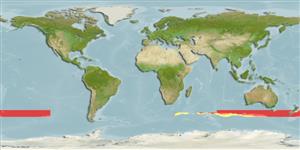Common names from other countries
Пластиножаберные (акулы и скаты) (sharks and rays) >
Squaliformes (Sleeper and dogfish sharks) >
Somniosidae (Sleeper sharks)
Etymology: Scymnodalatias: scymno-, referring to previous placement in Scymnodon; dalatias, referring to lack of dorsal spines like most sharks in the family Dalatiidae (sometimes included within Somniosidae). (See ETYFish); albicauda: albus (L.), white; cauda (L.), tail, referring to white markings on caudal fin. (See ETYFish).
Environment: milieu / climate zone / depth range / distribution range
экология
морской батипелагический; мигрирует в океане (Ref. 51243); пределы глубины 150 - 510 m (Ref. 6871). Deep-water; 42°S - 50°S
Eastern Indian Ocean: southern Australia. Southwest Pacific: New Zealand.
Size / Вес / Возраст
Maturity: Lm ? range ? - ? cm
Max length : 111 cm TL самец/пол неопределен; (Ref. 26346)
Краткое описание
определительные ключи | морфология | морфометрия
колючие лучи спинного плавника (общее число) : 0. Grey and white, mottled with large brown or black spots; tail mostly white with black tips (Ref. 26346). Dorsal fins small, pectoral fins angular, and an asymmetric caudal fin with a dark-tipped upper lobe (Ref. 6871).
Oceanic (Ref. 6871). A rare species known only from a few specimens taken by tuna longliners and trawlers (Ref. 6871). Ovoviviparous (Ref. 205), with at least 59 young in a litter (Ref. 26346).
Life cycle and mating behavior
Maturities | размножение | Spawnings | Egg(s) | Fecundities | личинки
Probably ovoviviparous (Ref. 6871), with at least 59 young (Ref. 26346). Distinct pairing with embrace (Ref. 205).
Last, P.R. and J.D. Stevens, 1994. Sharks and rays of Australia. CSIRO, Australia. 513 p. (Ref. 6871)
Статус Красного Списка МСОП (Ref. 130435)
CITES (Ref. 128078)
Not Evaluated
Угроза для людей
Harmless
Использование человеком
дополнительная информация
инструменты
Специальные отчеты
Скачать в формате XML
ресурсы в Интернет
Estimates based on models
Preferred temperature (Ref.
115969): 7.2 - 11.8, mean 9.2 (based on 20 cells).
Phylogenetic diversity index (Ref.
82804): PD
50 = 0.5625 [Uniqueness, from 0.5 = low to 2.0 = high].
Bayesian length-weight: a=0.00389 (0.00168 - 0.00901), b=3.13 (2.94 - 3.32), in cm Total Length, based on LWR estimates for this (Sub)family-body shape (Ref.
93245).
Trophic level (Ref.
69278): 4.1 ±0.5 se; based on size and trophs of closest relatives
устойчивость к внешним воздействиям (Ref.
120179): низкий, минимальное время удвоения популяции 4.5-14 лет (Fec=59).
Fishing Vulnerability (Ref.
59153): High to very high vulnerability (67 of 100).
